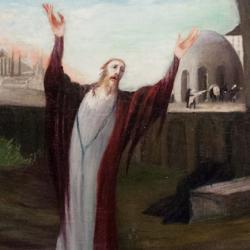As many dramatically-inclined Bible teachers have said, the page that separates Old and New Testaments shouldn’t be there. It’s theologically indefensible since it bewitches us into thinking that we have two Bibles instead of one.
That page is a disaster for literary reasons too. Without it, you’d read straight from Malachi 4 to Matthew 1:1, and it would go something like this: A day of burning is coming, the chaff will be cleansed, Elijah is coming before that great day of fire to turn the people because they are about to be smitten with a curse.
Continue reading, and . . .
“The book of Genesis” ( biblos geneseos ). Something’s happened. A dramatic turn. The curse and fire that Malachi predicted, where are they? We’re back to the beginning of the Bible, just when we thought we were at the end, so this beginning must be a new beginning. But how can that be? Did Elijah come? Did that fire ever fall to burn the chaff?
And who is this “Jesus Christ” who suddenly makes an appearance? Is he Elijah? He’s a king, because he is son of David. He is a king of the Jews because he is son of Abraham. What does He have to do with the day of fire and wrath? Is He going to bring the fire? Or keep it from coming? Or both?
And suddenly everything is bursting with life and vitality and fertility. Birth after birth after birth. Phoenix coming from Malachi’s fire.
We think that we’ve started a different book, one that is about a different set of characters and a different set of problems. We miss the questions that Matthew 1 poses. Without the page, we’d expect Matthew to answer the questions that Malachi left us, and he does. With the page, we think Matthew is answering completely different questions. If we keep that page, we lose the drama of Jesus’ sudden appearance, which is the drama of an unanticipated plot twist not the pseudo-drama of a new plot.











